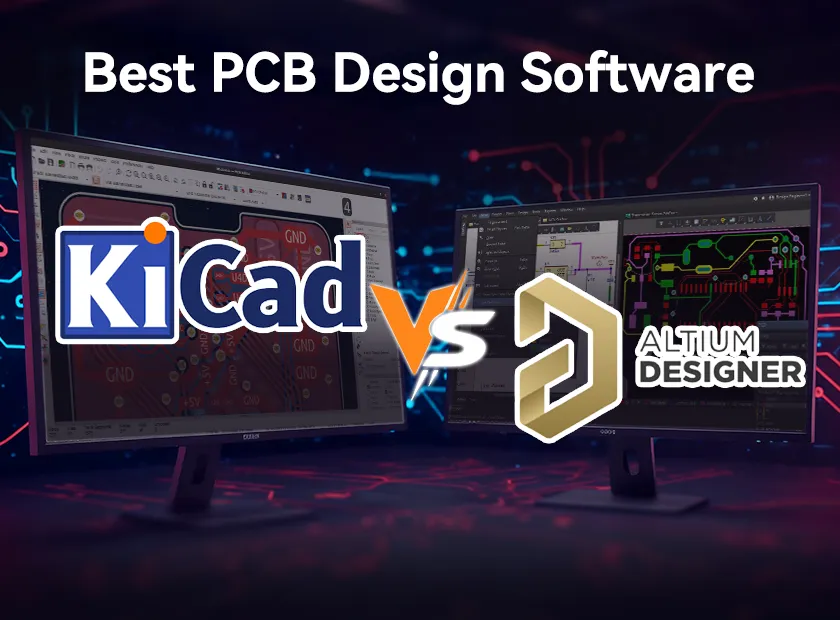Best PCB Design Software: KiCad vs Altium

Best PCB Design Software: KiCad vs Altium
When it comes to PCB design software, KiCad and Altium Designer stand out as two of the most popular choices, each representing a distinct philosophy.
KiCad, developed by Jean-Pierre Charras in 1992, is a completely free, open-source software supported by a passionate global community. It’s widely used by hobbyists, educators, and startups thanks to its accessibility and flexibility.
On the other hand, Altium Designer began as Protel in 1985 and has since evolved into a professional-grade, paid platform tailored for engineers and enterprises tackling complex design projects. While KiCad thrives through community-driven development, Altium boasts enterprise-level tools, dedicated support, and robust collaboration features.
Factors to Check When Choosing PCB Design Software
Pricing
Cost is a crucial factor, especially for individuals, startups, and small businesses. KiCad’s zero-cost model is a huge advantage, while Altium requires a significant investment.
Features
Look at what each tool allows you to do. From schematic capture to layout complexity, features determine both capabilities and efficiency.
Libraries of Components
A comprehensive library saves time by providing ready-to-use components rather than requiring you to create them from scratch.
Standard and Wide Use
Industry-standard software often ensures better compatibility, collaboration, and employability.
Feature Comparison
Schematic Capture
KiCad
KiCad offers an intuitive editor with support for hierarchical designs and BOM generation. Occasionally buggy, but effective for most users.
Altium
Altium provides advanced schematic capture with real-time error checking and a smooth, professional UI. Integrated 3D viewing enhances design clarity.
PCB Layout
KiCad
KiCad has all the fundamental routing tools and includes useful auto-shifting trace features, design rule checks, and 3D board viewing. KiCad doesn’t have a built-in autorouter by default, but external tools like FreeRouting can be integrated.
Altium
Altium is very good at complex routing with tools for high-speed designs. Strong autorouting, signal integrity analysis, realistic 3D modeling, and better layer management make it a powerhouse. It's worth mentioning that Altium includes STEP export/import for 3D mechanical integration, which is valuable in product design pipelines.
Collaboration and Integration
KiCad
KiCad supports version control systems, including Git. One can share files to collaborate, but does not have built-in team features. There’s ongoing development to improve collaborative workflows (e.g., KiCad 7 added some enhancements), but it still lacks real-time team collaboration tools. It also integrates with some mechanical CAD tools via community plugins.
Altium
Altium enhances performance with strong team functionality and its cloud-based platform for simultaneous collaboration. It integrates nicely with mechanical CAD software, being ideal for teams working on large-scale projects.
Library Management
KiCad
KiCad relies on volunteer-generated component libraries made available through GitHub. Library management is more hands-on, and quality can vary by contributor.
Altium
Altium offers rich libraries with parts from top-tier vendors. It includes tools for pricing, sourcing, and lifecycle tracking, which are parts of its premium service.
Use Cases: Which to Choose?
KiCad: Best for Beginners & Budget Projects
With an active community and open-source flexibility, KiCad is a top choice for students, hobbyists, educators, and startups. It’s a good choice for academic projects, open hardware projects, and early-stage prototypes.
Altium: Best for Professional & Complex Projects
Altium Designer is best suited for professional engineers and businesses that are working on complex, high-speed, or multi-layer PCB designs. Its high-end simulation, extensive component libraries, and built-in collaboration capabilities smooth the entire design-to-manufacturing process. Industries like aerospace, automotive, and medical devices rely on Altium for its simulation tools, compliance support, and collaborative features. It’s built for precision and scalability.
Pros and Cons of KiCad & Altium

In short, both Altium Designer and KiCad offer unique strengths, and the best choice depends entirely on your goals and situation.
As a free, open-source solution with essential features and strong community support, KiCad is ideal for beginners, hobbyists, educators, and startups. It's perfect for learning, prototyping, and budget-friendly projects.
Altium, on the other hand, is designed for professionals and teams tackling complex, high-speed, or multilayer PCB designs. With advanced tools, integrated collaboration, and enterprise-level support, it’s the right choice for industries like aerospace, automotive, and medical technology.
All in all, your choice should be guided by your project’s complexity, budget, and long-term needs. So, the ideal software depends on your specific goals and design needs.
Problem-Solving Time: Your Top Questions Answered
Q: Is Altium better than KiCad?
A: Altium is more powerful and suitable for complex, professional projects. KiCad is ideal for simpler needs, especially for beginners or those on a budget.
Q: Which PCB Design software is ideal for beginners?
A: KiCad. It's free, open-source, and supported by a vibrant community—perfect for learning.
Q: Can I switch from KiCad to Altium or vice versa?
A: Yes, but with some caveats. While it's possible to export and import files between the two using intermediate formats like Gerber or STEP, direct compatibility is limited. Converting projects may require manual adjustment of libraries, footprints, and layouts. Transitioning between platforms is easier at the schematic or early design stage than during complex layout phases.
Finished your PCB design? Get a Free Online PCB Quote Now
